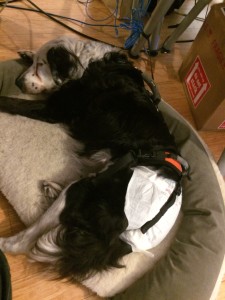After consulting with the oncologist, he explained that based on the location and description of the mass in her bladder, it is unlikely that this tumor could be a different diagnosis. There is not a 100% diagnosis without a biopsy, but Transitional Cell Carcinoma is the most common and likely for a bladder tumor.
Biopsy options would be invasive, expense, and risky. The biopsy options for her are:
- Use a needle to penetrate the bladder and collect a sample. The easiest & least invasive biopsy method, this can also spread the cancer, as it follows the needle’s path.
- Insert a catheter, and thread a needle through the catheter to collect a sample. This involves sedation/anesthesia and can be inaccurate in placement and retrieval.
- Insert a camera and scope to get a picture and grab a sample while looking at it. This is the most expensive option, and also requires complete anesthesia.
The danger of anesthesia increases with age, and for a 15 year old dog, its a good idea to avoid using anesthesia unless absolutely necessary.
The oncologist did comment that the location of the tumor was more favorable. Usually Transitional Cell Carcinoma tumors grow in the ‘neck’ of the bladder. The biggest concern being that it will grow over the urethra, preventing the ability to release urine. Patchy’s tumor appears to be growing farther up, with less chance of blocking the urethra.
Treatment Options for a dog with this type cancer is usually for quality of life.
- Surgical Removal- it is likely that Patchy’s tumor is in a location that allows for surgical removal. Dogs can still function with up to 50% of their bladder removed, but this increases frequency of urination and likely other bladder related issues. The surgery is major and would involve intense recovery & patience, as her bladder adjusts. While this option may seem most desirable, it is nearly impossible to confirm that all cancer cells were successfully removed. It would turn into a waiting game of how long it would take to grow back, and what the next options would be. Not to mention this would be a major surgery.
- High dose chemotherapy- generally meant to attack & destroy cancer cells, the side affects can drastically alter the quality of life. Given her age, and other health conditions, it appears that such a high dose would likely damage her quality of life. There is also very little chance that this treatment would permanently remove the cancer. There is a 30% chance of improvement with this method. Side effects would include intestinal distress & lowered immunity.
- Low dose chemotherapy- meant to manage and halt growth of the cancer cells, not eliminate them. This would be an oral medication taken at home. Side effects would be limited or mild. The hope is that this treatment would prevent spread & stunt tumor growth. Results are mixed. Focus would be on prolonging life while maintaining quality.
- Piroxicam- The most conservative option, this anti-inflammatory has shown mild success in treatment of this type of cancer, between 15-30%. Piroxicam is in the same family as Patchy’s current arthritis Anti-inflammatory medication, Rimadyl. Its not clear if switching would gain any benefit. Piroxicam is also known to cause GI issues.
- Do nothing- The actual conservative method.
The oncologist also took x-rays & blood work to rule out other ailments/spread of the cancer to her lymph nodes. The initial x-ray looks good.
As noted in her Oncologist discharge: “Prognosis for this tumor type is guarded and can be as poor as 4-6 months. However, if metastasis is not noted and a good response is gained, we can expect longer times in the 6-10 month range and potentially longer in some cases.”
I’m expecting the oncologist’s call tomorrow to go over blood work and results of additional x-ray study (conducted by a specialized radiologist).


